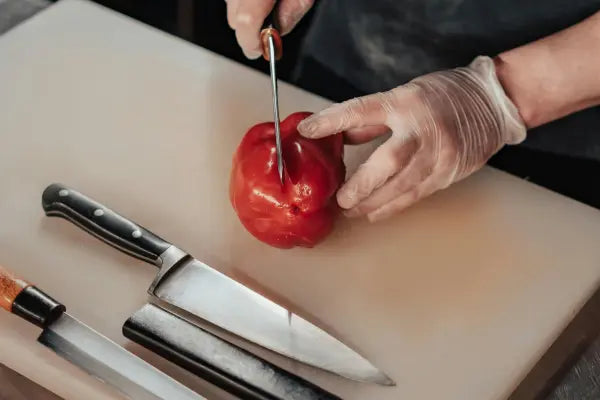If you’ve ever found yourself asking, What is mincing? Or what is a mince cut? Then you’re in the right place.
Previously, I didn’t realize mincing could make cooking easier and tastier; once I learned the skill and bought the right tools, it helped me a lot. This post explains what mincing is and covers the best way to do it with the right tools and technique.
What is Mincing? What is Mincing in Cooking? And, What is Mincing Used For?
To mince means cutting food into very small, evenly sized bits. In cooking, chefs often use mincing to create tiny bits of garlic, onions, herbs, or ginger so they blend smoothly into dishes. It helps to crush the ingredients to spread the flavor better.
So, what is mincing in cooking? It helps bring balance to your meals. For instance, if you put garlic in the minced form, it melts right into your sauces, and using minced herbs can give a simple dressing a fancy touch.
You may be wondering, What is mincing used for? I prep my ingredients by mincing them to blend them into the meal without them becoming noticeable. Think about dishes such as stir-fries, dishes filled with meat and sauces, or dressings. It’s the best option if you really want flavor, but also don’t want chunks.
What is a Mince Cut? How to Mince Cut
Now, let’s dive deeper into what a mince cut is. Mincing breaks ingredients into smaller pieces than a dice, but not as soft as a puree. It is smooth and level, so seasonings spread across all parts of the food.
So, here’s how to mince like a pro:
-
Firstly, start with peeled and cleaned ingredients.
-
Secondly, use a sharp chef’s knife for control and efficiency.
-
Thirdly, slice thinly, then turn and slice again to form sticks.
-
Then, cross-cut those sticks into tiny cubes.
-
Lastly, rock the knife over the pile to reduce the size even further if needed.
I always remind myself to take my time—mincing isn’t about speed; it’s about precision.
What Knife is Used for Mincing?
So, what knife is used for mincing? I mostly reach for a chef's knife. I like how these knives give my cutting a steady and manageable length, enough heft, and a slight curve in the blade to make mincing easy with a rocking motion.
But there are others worth considering:
- Because the edge is straight, up-and-down chopping with a Nakiri knife is very simple.
- Cleaver knives chop herbs and garlic surprisingly well. With their weight, they make the job of crushing and mincing much quicker.
-
If you’d prefer more control, a Gyuto is the best choice for thin and precise slices.
I’ve tested all of these, and each one has its own strengths.
Best Knives for Mincing
After testing many kinds of knives, I have identified my favorites for mincing.
1. 8" Gyuto Chef Knife | Shogun Series
This knife is a real power tool. This knife uses VG10 Damascus steel and a G-10 fiberglass handle, making it both balanced and durable. Because the blade has an 8–12° edge angle, mincing small pieces is much easier to do. It’s especially convenient that the broad blade is perfect for taking up minced ingredients all in one step.
2. 8" Gyuto Chef Knife | Daimyo Series
The knife’s 440C stainless steel blade and rosewood handle give it a style that always seems ready for work. Having a 13–15° edge helps get smooth cuts, and the lightweight handle prevents me from feeling tired when cutting for long periods. It works very well for all types of herbs and small vegetables.
3. 7" Cleaver Knife | Gin Series
Don’t let its size trick you. The VG-10 stainless steel and silver-ion coating make this cleaver perfect for everything from crushing to mincing. The flat side helps me a lot in smashing garlic before I mince it.
4. 7" Nakiri Knife | Samurai Series
This is a knife you’ll love if you love vegetables. The high-carbon steel construction allows Nakiris to part and mince delicate ingredients without damaging them. Since the knife has a flat edge, it gives me equal cuts, and my blade doesn’t go dull when I mince tomatoes or herbs.
The KOI series utilizes VG-10 stainless steel knives and has a lovely camphor wood handle. Because it’s light to use and features a 16–20° angle, it makes smooth, rocking movements possible. I include it in nearly all my cooking, and I’ve never been disappointed.
Conclusion
If you’ve wondered how to mince or what knife to use for mincing, this guide should give you all the answers. Mincing might not seem major, but it makes a big difference when you’re cooking. Doing something as basic as sprinkling even garlic in a sauce or chopping herbs finely helps you reach a new level as a cook.
I’ve seen that remarkable performance mostly comes from having high-quality tools. When I switched to Kyoku’s Shogun, Daimyo, Gin, Samurai, and KOI series knives, mincing became both simpler and much more fun. The high level of detail, balance, and strength of these knives is easy to see.
If you're serious about improving your prep game—or just tired of struggling with dull, awkward knives—I highly recommend checking out KyokuKnives. No matter if you’re cooking for the first time or you’re experienced, buying a reliable knife is a smart investment.
So, why not check their collection and buy a knife that will guarantee every slice, chop, and mince feels simple and nice?




